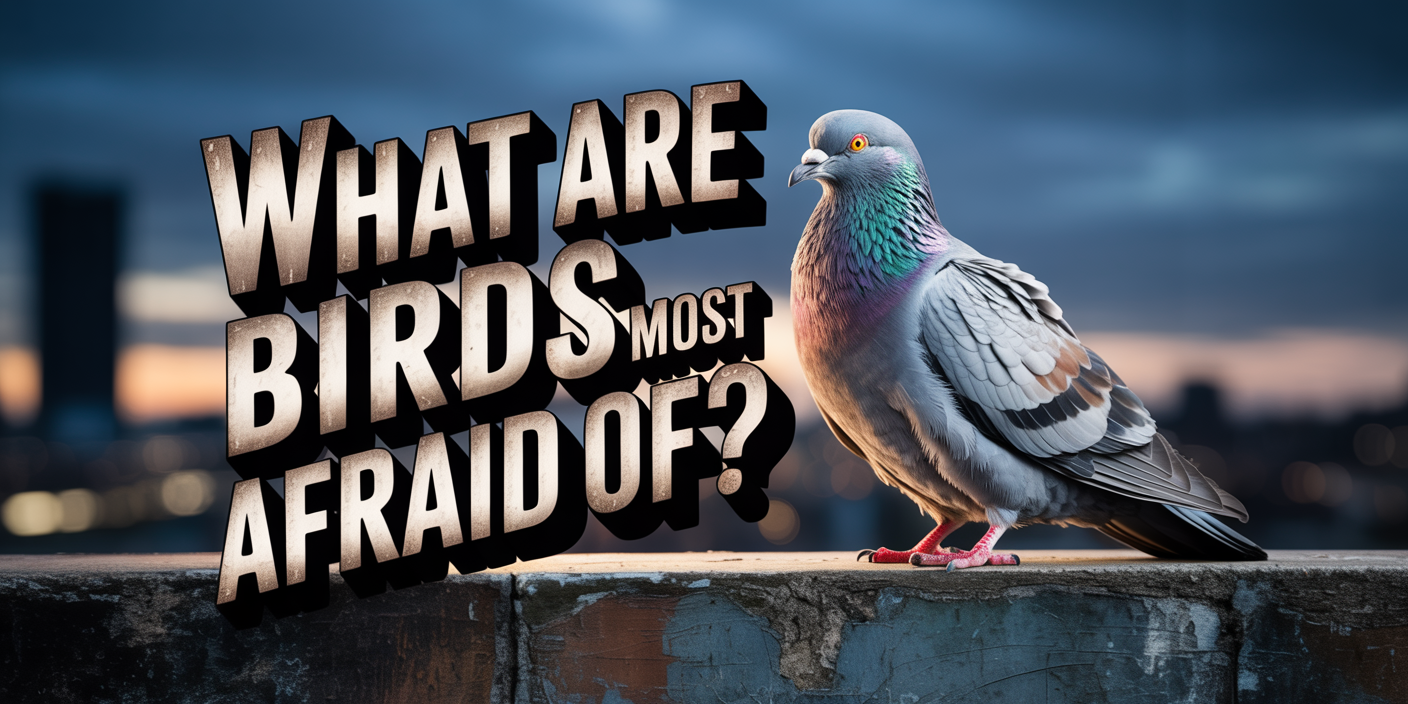Birds are most afraid of natural predators, sudden loud noises, reflective light patterns, unstable landing zones, and consistent human presence. These fear triggers tap into birds’ survival instincts, making them avoid areas that feel unsafe or unpredictable.
If you’ve ever found yourself scrubbing bird droppings off your patio furniture for the third time in a week, you’ve probably asked yourself, “What are birds most afraid of?” It’s not just curiosity, it’s about protecting your home, your car, and maybe your sanity. Birds may look harmless, but when flocks settle in, the mess and property damage they leave behind add up fast. From clogged gutters to scratched-up solar panels, ignoring the problem isn’t really an option.
The trick is understanding what actually sends birds flying the other way, not just sticking a plastic owl on your roof and hoping for the best. Different bird species respond to different cues, and those generic quick fixes you see online usually don’t hold up long term. At AAAC Wildlife Removal, we handle bird control professionally, and today we’re digging into the real answer to what birds are most afraid of, so you can keep your space peaceful and droppings-free for good.
Understanding Bird Fear: It’s Not Just About Loud Noises
If you’ve ever waved your arms or clapped your hands at a flock of pigeons, you already know birds react fast to sudden movements and sounds. That doesn’t mean every noise or flashy thing will keep them away long term. Birds are smart, especially species like starlings, crows, and pigeons. They quickly figure out what’s a real threat and what’s just background noise.
Instead of just making a ruckus, effective bird deterrence hinges on tapping into birds’ core survival instincts. Fear triggers for birds generally fall into a few clear categories:
- Predators: Birds naturally avoid places where they sense hawks, owls, or even larger humans consistently present.
- Unpredictable Movement: Spinning objects, flashing lights, and reflective surfaces mess with their visual flight patterns.
- Unstable Landing Zones: Birds avoid surfaces where they can’t perch safely, like angled spikes or swaying wires.
- Loud, Sudden Impacts: Air cannons, motion-activated alarms, or even trained dogs create impulses birds can’t ignore.
At AAAC Wildlife Removal, we focus on solutions that combine these fear factors instead of relying on just one. That’s why store-bought plastic owls rarely cut it, once birds realize nothing actually moves or changes, they’ll go right back to nesting where they shouldn’t.
The Top 5 Things Birds Are Scientifically Proven to Be Afraid Of
When it comes to making birds think twice about landing on your property, it’s not about random gadgets, it’s about understanding what their instincts tell them to avoid. Here’s where real-world tactics meet scientific backing.
1. Predator Shapes and Sounds
Birds have built-in survival systems that alert them to predators like hawks, owls, and falcons. That’s why decoys shaped like these birds work, but only if positioned correctly and moved regularly. Pairing visual decoys with predator calls or ultrasonic sounds increases effectiveness.
- Common tools: Owl decoys, hawk kites, predator sound systems
- Why it matters: Birds recognize predator silhouettes and vocal signals as threats
- Pro Tip: AAAC Wildlife Removal recommends rotating decoys weekly to prevent birds from adapting
2. Reflective Light and Movement
Flashing lights and reflective surfaces interfere with how birds navigate. Their eyes pick up on sudden glints and constant motion, which triggers a flight response. This is especially effective in open yards, patios, and warehouse spaces.
- Common tools: Mylar tape, reflective pinwheels, mirror strips
- Why it matters: Sudden light reflections confuse birds’ flight patterns
- Pro Tip: Install reflective items in breezy spots where constant motion is guaranteed
3. Sudden Loud Impulses
Birds dislike unpredictable noises more than steady ones. Motion-triggered alarms or even simple air cannons placed strategically can create an immediate sense of danger. Unlike constant background noise, these surprise sounds stop birds mid-landing.
- Common tools: Air cannons, motion-triggered audio alarms, sound blasters
- Why it matters: Birds adapt less to sudden irregular noises than continuous ones
- Pro Tip: Coordinate noise tools with physical barriers for layered deterrence
4. Physical Barriers and Spikes
While birds aren’t exactly “afraid” of spikes, they avoid landing in unstable or uncomfortable zones. Spikes, wires, and sloped surfaces remove their sense of landing security. This makes it a core strategy for signs, rooftops, and ledges.
- Common tools: Bird spikes, sloped ledge systems, tensioned wire installations
- Why it matters: Birds can’t perch safely, so they move on to easier locations
- Pro Tip: AAAC Wildlife Removal offers custom installations that blend with your building’s design
5. Trained Wildlife Removal Teams (Human Factor)
Believe it or not, birds can recognize when a location is actively monitored. Frequent human presence, especially from pros trained in humane bird removal, creates a dynamic threat birds learn to avoid.
- Common tools: Site inspections, removal services, property monitoring
- Why it matters: Consistent human intervention signals long-term danger to birds
- Pro Tip: Trust a licensed team like AAAC Wildlife Removal instead of going it alone—it’s faster and safer for both you and the birds
Why DIY Bird Deterrents Often Fail
A lot of folks try handling bird problems themselves before calling AAAC Wildlife Removal, and honestly, we get it. Online videos make it look easy, just hang up a shiny object or stick a plastic owl on your roof. The thing is, birds aren’t easily fooled for long. Once they figure out there’s no real threat, they’re right back to nesting and leaving droppings where they don’t belong.
The biggest reason DIY bird deterrents fail is inconsistency. Motion-activated gadgets need regular repositioning. Reflective tape needs replacing when it fades or stops moving. And static decoys like plastic owls are practically useless if they stay in one spot too long. Birds quickly adapt to patterns.
Common DIY mistakes include:
- Leaving decoys in the same spot for too long
- Relying on a single method instead of combining sound, movement, and barriers
- Ignoring the need for regular maintenance and repositioning
- Overlooking the specific bird species and its behavior patterns
Another frequent issue is using a one-size-fits-all approach. A setup that works against pigeons might not faze aggressive starlings or territorial woodpeckers. Professional teams like AAAC Wildlife Removal don’t just guess, we inspect the site, identify the species involved, and customize deterrents to fit both the bird’s behavior and your property layout. That’s how you get lasting results instead of wasted weekends and ineffective gadgets collecting dust.
Make Your Property a No-Fly Zone for Birds
So, what are birds most afraid of? It’s not just loud noises or shiny tape, it’s a combination of natural predator cues, unpredictable movement, sudden impacts, unstable landing zones, and consistent human presence. Birds have smart survival instincts, and they know when a property isn’t worth the hassle. The key is using these fear factors in a way that keeps them guessing, not letting them adapt and settle in again.
If you’re serious about protecting your home or business from bird damage, DIY methods only go so far. That’s where AAAC Wildlife Removal comes in. Our team doesn’t rely on one-size-fits-all solutions, we customize bird control plans based on your exact property layout and the bird species involved. From inspection to installation and follow-up, we help you make sure birds see your space as off-limits, permanently.
How AAAC Wildlife Removal Handles Bird Fear Tactically
When birds won’t take the hint, AAAC Wildlife Removal steps in with professional-grade solutions that actually work. We combine predator decoys, reflective barriers, sound deterrents, and expert property inspections into a custom plan built for your space, not some one-size-fits-all fix. Birds adapt fast, so we stay ahead with regular follow-ups and maintenance, making sure they know your home or business is permanently off-limits.
Skip the trial-and-error gadgets and call AAAC Wildlife Removal today. Our team knows exactly what birds are most afraid of, and how to use it to keep your property bird-free for good.




